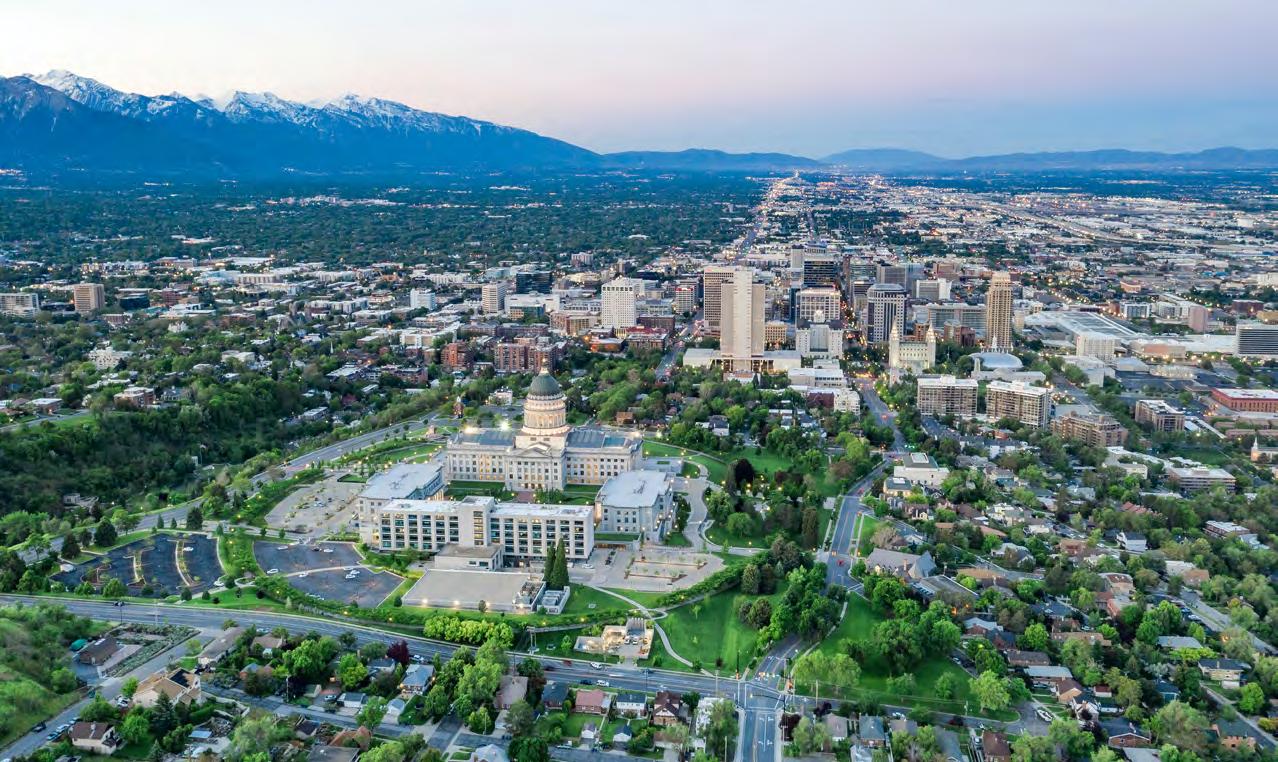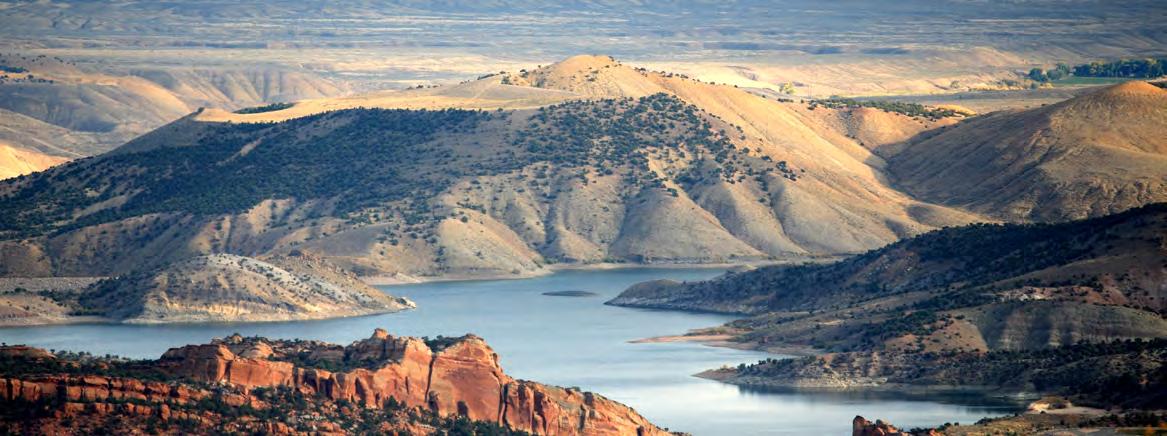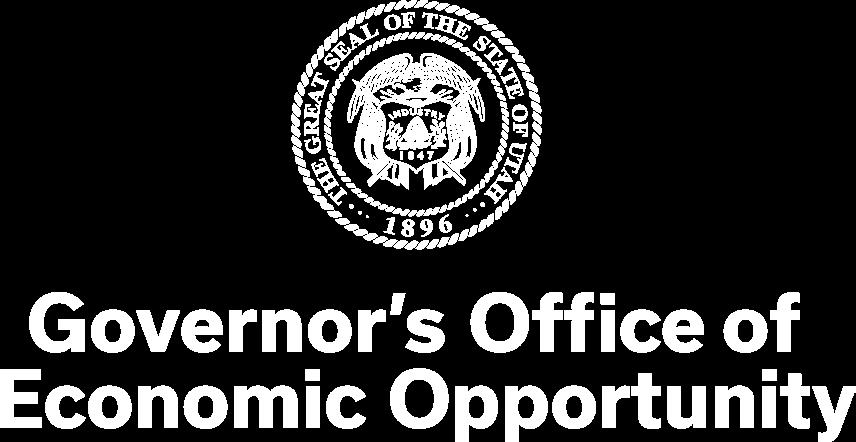








The Utah Governor’s Office of Economic Opportunity (GOEO) prepares an annual report for the Utah Legislature and the public. The report — published annually on Oct. 1 for the previous fiscal year — details the office’s programs, initiatives, and events. The 2024 Annual Report represents the period from July 2023 to June 2024, known as fiscal year (FY) 2024.


Under Gov. Spencer J. Cox’s direction, the Governor’s Office of Economic Opportunity provides resources and support for business creation, growth, and recruitment while also promoting tourism and film production in Utah. The office cultivates economic prosperity for all Utahns, leveraging federal, state, and private sector resources to implement programs in areas with the highest potential for economic development and opportunities for Utah residents.

Ryan Starks
Utah Governor’s Office of Economic Opportunity
Executive Director
801-538-8794
ryanstarks@utah.gov
The Governor’s Office of Economic Opportunity (GOEO) is committed to providing economic opportunities for all Utahns by cultivating economic prosperity and sustaining the world’s greatest economy and quality of life. Whether helping a small business grow or bringing a Fortune 500 company to the state, GOEO is here to help make things happen.
Utah continues to shine as the nation’s top economy. Esteemed national publications have praised Utah’s economic strength. U.S. News & World Report ranked Utah as the Best State for the past two years, and Rich States Poor States has ranked Utah No. 1 for Best Economic Outlook for 17 consecutive years. Additionally, WalletHub recognized Utah as the Best State to Start a Small Business and the No. 2 Best State Economy. The state’s list of accolades keeps growing.
GOEO supports Utah’s economic progress through various innovative initiatives. Our staff is dedicated to working across the state in numerous areas. Over the past year, GOEO has seen notable transformations in its work, including adding UPSTART, an in-home, technology-delivered kindergarten readiness program, and expanding the Startup State Initiative entrepreneurial ecosystem resource for startups and small businesses. The office also helps meet the capital access needs of Utah’s small businesses through a $69 million federal State Small Business Credit Initiative contract, known as the Utah Small Business Credit Initiative (USBCI).
Utah’s entrepreneurial drive and business-friendly environment continue to position the state as a national and global leader. Our office is excited about the opportunities ahead and is dedicated to fostering economic prosperity throughout the state.
Sincerely,


• Support innovation, entrepreneurship, and small business creation and growth.
• Promote a business-friendly environment that enables the private sector to create high-paying jobs.
• Create policy recommendations that develop, direct, and coordinate Utah’s statewide and regional economic development strategies.
• Facilitate alignment between industry and education to train a world-class workforce.
• Engage with targeted industries to build strategies that maintain a diversified economy and strengthen the business supply chain.
• Utilize sustainable incentives to address challenges in affordable housing, the environment, and transportation, and provide public benefits like infrastructure and workforce development.
• Encourage collaboration and partnerships between state and local government, nonprofits, and the private sector.
• Provide statewide economic opportunities to support a robust quality of life for all Utahns in our urban and rural communities.
• Expand the tourist experience of Utah’s natural and cultural wonders and promote local film production.
• Maintain a database for community reinvestment agencies to track projects and taxing entities.
• Offer loans to small businesses through Utah lending partners as part of the State Small Business Credit Initiative.
Develop and sustain the world’s greatest economy and quality of life.
Cultivate economic prosperity for all Utahns.

• Collaborative partnerships
• Exceptional communication
• Working at the speed of business
• Community stewardship
• Superb customer experience
• World-class research and data

For information on programs and initiatives, team headshots, and staff contact details, visit econ-opp.fyi/directory.


GOEO’s business services team partners with the U.S. Treasury, the U.S. Small Business Administration, the Salt Lake and Utah Valley chambers of commerce, Suazo Business Center, the Women’s Business Center of Utah, and many others to offer resources and support to Utah small businesses. Resources include consulting, training, capital, grants, and other tools to help small businesses succeed.
In January 2023, Gov. Cox appointed Brad Bonham as the state’s first entrepreneur-in-residence. He also serves as a member of the GOEO board. The office’s business services team works with the state’s entrepreneur-in-residence through the Startup
State Initiative to support Utahns’ entrepreneurship journey. The initiative also makes policy recommendations to the Legislature to benefit Utah entrepreneurs.
Programs and services offered to small businesses include:
The APEX Accelerator program helps Utah businesses identify and secure government contracts by providing those businesses with free consulting services that prepare them to compete in the government marketplace.

From July 1, 2023, to June 30, 2024, APEX Accelerator:
• Completed 2,670 hours of free consulting services.
• Consulted 559 new clients.
• Helped Utah companies win $1,018,228,273 in federal, state, and local contract awards.
• Organized and hosted 76 in-person and virtual events, including the APEX Accelerator Symposium with 220 attendees and the Federal Lands Outreach Conference with 65 attendees.
The Business Recruitment and Expansion team manages GOEO’s financial incentives for local and out-of-state companies seeking to expand in or relocate to Utah. The team is pivotal in supporting regional economic development across the state. GOEO empowers local communities to craft and implement robust economic strategies tailored to their unique strengths and opportunities by offering various services. It fosters collaboration between state agencies, local governments, and private sector partners, driving initiatives that enhance infrastructure, workforce development, and business expansion.
The Center for Rural Development works with Utah’s rural counties, communities, and businesses, providing economic development resources. The center administers the Rural Opportunity Program and assists with other
programs to help local governments and businesses grow and prosper.
The International Trade and Diplomacy team coordinates and manages diplomatic engagements within Utah and globally. In partnership with World Trade Center Utah, they promote Utah’s business community and attract foreign direct investment.
The Startup State Initiative celebrates, inspires, and empowers Utah entrepreneurs and their supporters by encouraging business creation within the state and providing support throughout the business lifecycle. It comprises a statewide entrepreneurship brand and business resource portal available at startup.utah.gov.
The Utah Broadband Center facilitates the expansion of high-speed internet to Utah businesses and households. GOEO works with broadband providers, local, state, and federal policymakers, consumers, communities, and other partners to support broadband deployment, improve efficiencies, and expand statewide access and usage.
The Utah Center for Immigration and Integration assists businesses in Utah with identifying pathways for recruiting and retaining international talent. It coordinates with state and federal government partners on immigra-

tion policies and programs. The center also oversees a statewide task force with local officials, business sector representatives, and community stakeholders to advise on areas that promote economic opportunities for immigrants and New Americans in Utah.
The Utah Film Commission supports Utah businesses involved in film, television, and commercial production — ranging from catering to equipment rental — by promoting and incentivizing film production across the state.
The Utah Innovation Center supports the state’s targeted industries by assisting Utah innovators with federal research and development dollars through the Small Business
Innovation Research (SBIR) and Small Business Technology Transfer (STTR) programs. It catalyzes technology innovation in the state and helps small businesses compete successfully to win non-dilutive research and development funding.
The Utah Small Business Credit Initiative (USBCI) is a federal loan program funded by the U.S. Treasury (part of the State Small Business Credit Initiative) with $69 million to expand access to capital for Utah small businesses. The program is most helpful to small businesses that cannot access traditional bank loans due to limited equity or time in operation.
The Utah Office of Tourism supports Utah entrepreneurs via marketing, stewardship, and destination development. The office creates messaging that promotes statewide visitation, supports local businesses, and strengthens Utah’s economy. The office enhances and develops economic opportunities for residents and visitors by encouraging responsible exploration and collaboration with local communities.
The Utah Office of Regulatory Relief allows businesses to temporarily experiment with products, production methods, or services, enabling entrepreneurs to determine product effectiveness with their clients. The office additionally provides valuable information to policymakers about the appropriate scope and scale of regulation for new products, production methods, or services.

Through the Center for Rural Development, GOEO provides tax credit incentives, grants, and other resources to help local governments and businesses grow and prosper.
Examples of Center for Rural Development programs that served rural Utah in FY 2024 include the following:
The Rural Opportunity Program includes three grant funding opportunities that benefit rural Utah: the Rural County Grant, the Rural Communities Opportunity Grant, and the Rural Employment Development Grant. Over $12 million was awarded from these three grants in FY 2024.
The RCG program awards $200,000 to each of the 24 rural counties in Utah. With the advice of their county economic opportunity advisory boards, each county plans and implements projects and activities that enhance business and general economic development. These projects and activities include business recruitment, development, and expansion;
workforce training and development; infrastructure; industrial building development; and capital facilities improvements for business development activities. In FY 2024, $4.8 million was distributed to the rural counties.
In the fourth year of administering the RCG, GOEO saw more engagement and activity from each county’s economic opportunity advisory board. These boards contribute to the economic development decisions made for the county.
One notable challenge is some counties have trouble expending all the grant funds in a single fiscal year. As a result, we implemented a new accountability measure that considers funds encumbered for ongoing projects that cross fiscal years.
Examples of economic development projects and activities by rural counties using Rural County Grant funds include:
• Subgrants to businesses for capital investments and job retention.

• Funding support for economic development professionals.
• Event amenities and venue improvements.
• Infrastructure improvements for downtown place-making.
• Buy-local sales promotions.
• Owner and manager training in practical business skills and customer service.
• Business leadership and training academies.
• Market research and feasibility studies.
The RCOG is a competitive funding program that expands opportunities to rural communities — not only the rural counties but also the cities and towns within them. Rural Associations of Governments can now apply for RCOG for regional projects. Awards to rural communities may be up to $600,000. In FY 2024, $7,307,256 was awarded to 20 rural communities for business recruitment, development, and expansion; workforce training and development; infrastructure; industrial building development; and capital facilities improvements for business development.
Due to the newly recognized definition of a rural community, funding requests by qualified community applicants far exceeded the funds allocated for the grant. As a result, we had more eligible applicants than the previous year. Each award was contracted for up to two years on a 90/10 basis, meaning 90% of the awarded funds are delivered upon award approval, and the remaining 10% will be issued when projects and activities are completed.
Examples of economic development projects and activities by rural communities using RCOG funds include:
• Public infrastructure for downtown business development.
• Rehabilitation of a historic commercial sector to support local businesses.
• Industrial park development to attract diverse business opportunities.
• Upgrades to tourist destination amenities.
• Support for key industry workforce training.
• Road improvement to accommodate heavier truck traffic in distribution corridors.
• Upgrades to main transmission lines to support high-growth businesses.
• Aviation training and facilitating expansion for larger commercial aviation practice.
We believe the Rural Opportunity Program has been an effective and essential tool for rural Utah and recommend that this program continue.
The REDI grant offers direct support to businesses. Growing companies in rural Utah that create and retain new high-paying jobs can apply for $5,000 to $6,000 per position, provided they maintain the job for at least 12 months. This program defines high-paying jobs as jobs that pay 110% of the county’s annual wage. Contracts for this grant extend across fiscal years.
One of the main challenges REDI participants faced during FY 2024 was being able to create and fill the projected number of positions during the first six months of their contract periods and retain those employees.
In FY 2024, 20 businesses applied for a REDI grant. Of those, 14 contracts were executed, with six agreements under negotiation. The REDI grant currently has obligations of $1.4 million and projects the creation of over 300 new jobs in rural communities over the next few years.
Applications received during FY 2024 came from businesses in the following rural counties:
• Beaver
• Box Elder
• Carbon
• Emery
• Grand
• Juab
• San Juan
• Sevier
• Wasatch
• Weber
As a post-performance program, reimbursement is issued after verifying new positions have been created and the annual gross wage meets the required criteria at the end of 12 consecutive months.
U.C.A. 63N-4-503
The Rural Coworking and Innovation Center grant assists in creating facilities designed to provide individuals working within designated rural areas with the infrastructure and equipment needed to participate in today’s online workforce.
Funding previously allocated to this program has been redirected to the RCOG. Future requests for the development of coworking and innovation centers will be made through an RCOG application.
Coworking and innovation centers are now open in:
• Blanding, San Juan County
• Cedar City, Iron County
• Fountain Green City, Sanpete County
• Green River, Emery County
• Hanksville, Wayne County
• Moab, Grand County
• Monticello, San Juan County
• Orangeville, Emery County
• Panguitch, Garfield County
• Price, Carbon County
• Vernal, Uintah County
U.C.A. 63N-2-106(2)
In FY 2024, the GOEO board recommended post-performance tax credits to nine companies

through a change to the Rural Economic Development Tax Increment Financing (REDTIF) program focused on rural Utah. These benefits were extended to companies in seven rural counties. Together, these companies have committed over $714 million in capital expenditures within our rural communities and plan to create 1,262 new full-time, high-paying jobs that meet or exceed county wage standards. The office expects the number of REDTIF projects to increase as knowledge of the program spreads.
Rural counties with REDTIF projects in FY 2024:
• Beaver
• Box Elder (2)
• Cache (2)
• Sanpete
• Summit
• Tooele
• Wasatch
GOEO considers all of its programs and initiatives crucial to supporting Utah’s small businesses in rural Utah. A few examples include:
• GOEO leadership tour of “24 in ‘24” focused on strategic meetings with county and local leaders to discuss economic prosperity across each county. The purpose was to review past economic achievements while exploring future goals and opportunities that could be driven at the local and county levels with state support and resources.
• Enhanced Center for Rural Development service delivery model via outreach managers to foster enhanced interactions with business and community leaders while addressing local economic challenges and opportunities.
• Grant awards to businesses and communities in rural Utah of approximately $47 million.
• Utah Office of Tourism promoted visitation, tourism, and uniquely Utah experiences across the state.
• Utah Film Commission suppor ted and advanced film production throughout the state.
• Utah Innovation Center helped small technology businesses secure non-dilutive
research and development funding.
• APEX Accelerator’s regional offices supported Utah small businesses seeking government contracts.
• Utah Broadband Center worked to ensure increased internet speeds throughout the state, especially in rural Utah.
• Corporate retention and recruitment, especially the state’s tax credit REDTIF program, supported Utah businesses and companies in rural parts of the state.

The APEX Accelerator program helps Utah businesses compete in the government marketplace by providing free consulting services, workshops, webinars, and networking opportunities.
From July 1, 2023, to June 30, 2024, APEX Accelerator:
• Consulted 101 new clients in rural Utah (18% of all new clients).
• Helped Utah rural companies receive $84,682,165 in federal, state, and local contract awards.
• Held 19 events in rural Utah (accounting for 25% of APEX Accelerator events during the fiscal year).
Examples of events from this fiscal year include several Associated General Contractors workshops in St. George; the Manufactured in Southern Utah meeting in St. George; the BIG (Beaver, Iron, Garfield) Chamber presentation; the Carbon County Chamber presentation; participation in the Utah Advanced Materials and Manufacturing Initiative (UAMMI) Crosstalk event in Price; and the San Juan County Business Summit. APEX Accelerator was also one of the sponsors of the One Utah Summit in Cedar City in October 2023.
GOEO announced the 2024 Rural Utah Business of the Year. This honor goes to a rural Utah business that:
• Demonstrates innovation
• Has an entrepreneurial spirit
• Is making a positive economic impact on
its local rural community measured by job creation, revenue growth, and contribution to the local tax base
• Is a good corporate citizen
The business should demonstrate a commitment to sustainability, both environmentally and socially, have growth potential, and have effective leadership and management practices in place with strong industry excellence. Overall, the business should have a positive impact on the rural area in which it operates. We are pleased to announce the 2024 Rural Business of the Year is Crusoe Energy Solutions, a pioneering company based in Duchesne County.
Crusoe is on a mission to align the future of computing with the future of the climate by building and operating clean computing infrastructure. By unlocking stranded sources of energy to power artificial intelligence (AI), crypto, and other high-performance computing applications, Crusoe is creating innovative solutions that reduce emissions rather than add to them. In 2023, it partnered with XCL Resources to launch a groundbreaking project in Utah’s Uinta Basin, utilizing its Digital Flare Mitigation technology to slash 273,000 tons of carbon dioxide annually while boosting local employment. Crusoe’s role in reducing methane flares is a unique approach to converting flared gas into electricity for data centers. Crusoe continues to lead in sustainable technology, blending environmental stewardship with cutting-edge computing solutions across global markets.
The award was presented in October 2024 at the One Utah Summit in Cedar City, Utah, at Southern Utah University.
The Utah Innovation Center supports innovators in the state by connecting them with a broad range of assets and resources, including the chance to apply for equity-free research and development funding through the federal Small Business Innovation Research (SBIR) and Small Business Technology Transfer (STTR) programs.
The center is proud to have facilitated Utah small businesses receiving approximately $375 million in research and development funding since its inception. In addition, the team promotes connecting and collaborating with Utah’s world-class industry, higher education, and entrepreneurship support organizations.
The team offers its services statewide and free of charge, giving Utah’s technology-oriented companies a distinct advantage in today’s competitive environment.
U.C.A. 63N-3-204
In FY 2024, the Utah Innovation Center awarded 23 microgrants totaling $81,000 to Utah businesses applying for the SBIR/ STTR program, including six companies from underserved populations and rural counties, and $560,000 in nonrecourse loans to businesses that won grants or contracts. One nonrecourse loan went to a rural business in Cache County. This funding supports small businesses in Utah’s targeted industries in the research and development space.

The Utah Broadband Center (UBC) works to ensure all Utahns have access to reliable and affordable high-speed internet service. Broadband is crucial for a thriving economy in today’s world, whether urban or rural. Providing high-speed internet to every home and business will catapult the state’s trajectory as the fastest-growing and best economy in the nation and globally.
• Facilitates the Utah Broadband Alliance, whose participants include public, private, and nonprofit stakeholders working to bring high-quality broadband to Utah.
• Convenes the Utah Broadband Center Advisory Commission, comprised of state legislators and agencies, which recommends UBC’s use of federal funds.
• Maintains the statewide residential and commercial broadband availability maps.
• Administers the state’s Broadband Access Grant program.
• Develops a statewide Digital Connectivity Plan.
• Administers the state’s federal Broadband, Equity, Access, and Deployment and Digital Equity programs.
In FY 2024, the state Legislature reallocated $5 million of federal Capital Project Funds to the $10 million Broadband Access Grant allocated in a previous year. With matching funds, the dollars will bring high-speed fiber optics to 535 rural households and businesses.
In FY 2024, working with the Utah Broadband Center Advisory Commission, local governments, nonprofits, state agencies, tribal governments, and internet service providers, UBC finalized the state’s Digital Connectivity and Digital Access plans and submitted them to the National Telecommunications Information Administration (NTIA) per a requirement for the state’s $317 million allocation in federal funds through the Broadband, Equity, Access, and Deployment (BEAD) program. By addressing infrastructure deployment, affordability, and accessibility through digital skill building, the state plan serves as a resource to ensure everyone, regardless of socioeconomic status, has access to high-speed internet and can safely use it.
As part of the BEAD program, UBC administered the state’s broadband availability challenge process in FY 2024 to verify unserved broadband serviceable locations eligible for infrastructure funds. Potential challenge participants included local and tribal governments, nonprofits, and internet service providers. Approximately 190 challenges were submitted, affecting over 32,000 unique locations. The final map of validated locations will be submitted to NTIA for approval before launching the state’s Broadband Infrastructure Grant. The challenge and grant processes are based on the state’s initial proposal submitted by UBC in FY 2024 to NTIA outlining the strategy to ensure universal broadband service is achieved statewide.
The Business Recruitment and Expansion team helps accelerate business growth and job creation through sustainable, targeted expansions and relocations. The team’s primary economic development tool is Utah’s Economic Development Tax Increment Financing (EDTIF) program. Through this program, financial incentives are available for select companies that:
• Create new, high-paying jobs
• Help improve the standard of living
• Increase the tax base
• Attract and retain top-level management
• Diversify the state’s economy
Using the criteria listed above, the team recommends financial incentives for local and out-of-state companies seeking to expand or relocate to Utah. The GOEO board votes on all proposed incentives in a public meeting, and the office’s executive director provides the final sign-off on all awarded incentives. Incentives are offered as tax credits or grants. They are only disbursed after the company meets contractual performance benchmarks, including job creation, capital expenditure, and payment of new state taxes.
SINCE ITS INCEPTION IN 2005, APPROXIMATELY TWO-THIRDS OF THE COMPANIES PARTICIPATING IN THE STATE’S TAX CREDIT INCENTIVE PROGRAM ARE UTAH-BASED.
Projections based on the FY 2024 EDTIF/ REDTIF approvals
20 participating companies
Over $2.4 BILLION projected capital investment
Over $539 MILLION projected new state revenue
8,549 new high-paying jobs projected
Over $6.2 BILLION projected new state wages in 20 years
Trends for the year included more projects off the Wasatch Front and into rural Utah, as well as investments in industries such as technology and automation.
Thanks to modifications of the EDTIF program for rural areas — the Rural Economic Development Tax Increment Financing (REDTIF) post-performance tax credit program — projects located in rural areas of the state qualified for more significant incentives. With this tool, Utah has seen unprecedented economic opportunities flow to its more rural communities, with nine of this year’s 20 approved projects choosing a rural site. These projects include more than 1,200 high-paying jobs and more than $700 million in capital investment.

GOEO’s International Trade and Diplomacy team partners with international organizations in Utah, including World Trade Center Utah, to coordinate the state’s international business promotion activities. These include trade missions, trade shows, and business workshops.
Last year, GOEO hosted more than 60 dignitaries from around the world. Additionally, the International Trade team collaborated with the governments of the United Kingdom, Mexico, and Région Sud of France to execute Utah’s various international partnership initiatives.
The team builds lasting international relationships for Utah by coordinating with foreign governments and hosting dignitaries, including heads of state, ministers, ambassadors, consuls general, and other international leaders.
In FY 2024, GOEO and WTCUtah organized a trade mission to Mexico City and Monterrey, during which 36 government, business, and community leaders participated in 27 activities focused on advanced manufacturing, technology, and diplomatic relations.
Utah creates sustainable advantages around emerging and mature workforce sectors by supporting and building specific industries in its robust economy. The state has five targeted industries selected for current and potential contributions to its growing economy.
Utah’s advanced manufacturing industry includes cutting-edge companies dedicated to expanding advanced materials, manufacturing, technology development, and design sectors. Manufacturing is one of Utah’s largest industries, making significant GDP contributions to the state. On average, manufacturing jobs pay 38.6% more than other industries. In the past year, the private sector has added approximately 1,400 new manufacturing jobs.
Utah’s aerospace and defense industry includes many widely known and specialized companies contributing to the commercial and defense supply chains. It accounts for over 1,500 companies and organizations and 31,000+ jobs. The industry is projected to grow more than 12% in the next decade. One specific area with new growth opportunities is within advanced air mobility (AAM). Utah is proactively leading the nation in its AAM efforts, with plans to deliver large cargo and passengers as part of its normal operations within the next decade.

Utah’s financial services industry and workforce include commercial and industrial banks, credit unions, fintech businesses, insurance organizations, and other financial services enterprises. In 2023, the industry contributed 8.4% of Utah’s gross domestic product. Utah is home to 15 of the country’s 24 industrial banks. Utah currently holds over $206 billion in assets in its industrial bank companies, which amounts to 85.6% of all assets held in the U.S. by industrial banks.
Utah’s life sciences and healthcare industry is the nation’s third fastest-growing life science community. In the past decade, life sciences have experienced an average of 5.1% annual job growth. The industry supports over 1,600 employers supplying medical devices, pharmaceuticals, diagnostics, genom -
ics, digital health, biological, medical labs, and contract manufacturing. Life science firms are located in rural and urban parts of the state, with 21 out of the 29 counties having at least one life science firm.
Utah’s software and information technology industry has been at the forefront of innovation, housing cutting-edge companies since the 1980s. The industry is an impactful economic driver, with over 9,500 IT-related companies and organizations calling Utah home and job growth averaging 5% annually (2012 to 2022). However, in 2023, the state saw slower growth than usual, with employment in financial services growing by just 0.1%. Despite this slowdown — likely in response to high interest rates — projections for future growth in the industry remain robust.
The Utah Office of Tourism is integral to GOEO by stimulating traveler spending in the state. It partners with local communities to market the state and to enhance and develop visitor economies to benefit residents, visitors, and stakeholders. The office created the Red Emerald Strategic Plan to guide these efforts, identifying five imperatives for promotion and product development:
• Continue powerful branding
• Prioritize quality visitation
• Enable community-led visitor readiness
• Distribute visitation
• Improve organizational effectiveness
The FY 2024 marketing campaigns attracted travelers willing to spend more money and participate in more activities. The campaigns also educated visitors on how to travel responsibly and engage thoughtfully in our local communities. The Southern Utah/Forever Mighty/Northern Utah advertising campaign influenced more than 1.5 million Utah leisure trips and nearly $3 billion in visitor spending. The ski campaign also performed well, influencing about 435,000 trips, resulting in approximately $1.2 billion in visitor spending.
International visitation is reaching normalcy for many inbound markets, resulting in increased efforts in earned media, paid media, and travel trade campaigns with tour operators to inspire and convert international visitors to spend more time and money in Utah. The team hosted 36 familiarization tours and press trips in Utah, inviting international journalists and tour operators to experience the state’s unique offerings firsthand. Hosted
media include The Canadian Geographic, The Toronto Sun, Outlook Traveller India, Armchair Explorer Podcast, Explore Magazine, Studio 10 (Australia Morning Show), and others. They also participated in 10 international missions and global trade shows. These included:
• Brand USA Korea/Japan Mission
• Governor’s Mexico Trade Mission and Brand USA Mission
• Toronto Ski Show and Canada Media Mission
• Switzerland/Austria Mission
• India Mission and Brand USA Mission
• France Mission
• North England, Scotland, and Ireland Mission
The office continued to engage and support local communities and destinations through several programs and grants. In FY 2024, 55 grants totaling $4.7 million were awarded from the Traditional Co-Op Marketing Program. Of these grants, 36 were awarded to organizations in rural communities throughout Utah. Since its creation in FY 2006, the cooperative marketing program has funded 997 applications totaling $58 million and extended the state’s brand to $116.1 million in out-of-state marketing dollars.
The Office of Tourism staff meets regularly with local officials to understand their needs and how to best assist in developing their visitor economies. The office issued 20 Economic Development Administration grants totaling $700,000. Counties and cities will use this federal funding for feasibility and
economic development studies, product development, and enhanced infrastructure, such as signage, in their communities.
The office completed its third phase of a statewide resident sentiment survey conducted by the Kem C. Gardner Policy Institute to
gauge resident attitudes regarding travel and tourism. Most Utah residents have favorable views of tourism, but there are concerns about housing prices and environmental impact — particularly in communities that serve as gateways to Utah’s most visited attractions.


The year 2024 holds special significance because it marks 100 years since the first movies filmed in Utah and the 50th anniversary of the Utah Film Commission. For a century, Utah’s breathtaking landscapes have inspired filmmakers, offering audiences worldwide a chance to visit Utah through countless classic films and popular television shows.
The Utah Film Commission plays a vital role in the success of GOEO by promoting the state as a destination for film, television, and commercial productions. Film production creates jobs in the creative sector, supports local businesses, and encourages tourism across the state. The Rural Utah Incentive Program provides additional funding for productions that shoot at least 75% of production days in a rural county.
Film production continues to be a reliable economic driver that impacts the entire state. In the last 10 years, Utah’s film incentive created over $600 million in direct spending by productions and related vendors. A 2021 study from Olsberg SPI commissioned by the Motion Picture Association of Utah revealed how valuable film production is in the state. It found that Utah’s economy receives $7 for each tax dollar spent on the film incentive tax credit.
The Utah Film Commission also serves as a liaison to the broader entertainment industry by supporting local film events and working with higher education to create workforce training opportunities around the state.
• $6.39 million in state film incentives was awarded to 25 productions shooting in Utah, including a mix of local and out-ofstate feature films and TV series, yielding a total estimated spend of $49.1 million.
• 55% of all Utah filming locations are in rural counties.
• 25 Utah communities are certified by the Film Ready Utah program to support film productions and enable economic impact across the state.
• A 2023 Strategic Marketing and Research Insights study estimated $600 million per year in Utah film-motivated tourist spending over 10 years, with up to 37% of visitors indicating that a film or television series was among the primary motivators for visiting a particular destination in the state.
U.C.A. 63N-20-107
First developed and implemented in 2009, UPSTART is a legislatively funded statewide program that uses a home-based educational technology program with strong parental involvement and engagement to develop school readiness of preschool children. UPSTART delivers individualized reading, math, and science curriculum, with an emphasis on reading, to preschool children across the state.
Selected through the RFP process, Waterford Research Institute manages the UPSTART program as an independent contractor for the state of Utah now through June 2029.
Prior to the end of the calendar year, GOEO will provide an annual report to the Education Interim Committee. Learn more at business.utah.gov/upstart.

The Utah Small Business Credit Initiative (USBCI) is the state’s program for the federal State Small Business Credit Initiative (SSBCI). It provides additional access to credit through two lending programs: the Capital Access Program (CAP) and the Loan Participation Program (LPP).
• Capital Access Program — provides lender loss protection to help lenders fund projects they typically may not fund or where the lender’s risk may be higher due to a non-collateralized loan. The CAP loan program best suits employers with fewer than 500 employees and capital needs between $25,000 and $250,000.
• Loan Participation Program — enables small business owners to obtain a reasonable rate and term on mediumto long-term financing through a collateralized term loan. LPP assists Utah employers with fewer than 750 employees and capital needs between $10,000 and $1,000,000.
The U.S. Treasury has reviewed and approved USBCI’s CAP and LPP loan programs to help Utah’s small businesses, especially by supporting the state’s very small businesses (VSB) and socially and economically disadvantaged individual (SEDI) owned businesses.
Of the state’s $69 million allocation from the U.S. Treasury, $58.7 million is designated
for the LPP to enhance financial support for Utah’s small businesses. Meanwhile, $10.4 million is allocated to CAP, which focuses on facilitating access to capital for eligible businesses across the state.
In November 2022, the U.S. Treasury signed an agreement with GOEO to provide $69 million for the state’s SSBCI program. The funds are available in three tranches as follows:
• Tranche 1 — $23 million for the period of November 2022 to November 2025.
• Tranche 2 — $23 million for the period of November 2025 to November 2028.
• Tranche 3 — $23 million for the period of November 2028 to December 2030.
GOEO received funding for Tranche 1 in November 2022. GOEO will access Tranche 2 as soon as the state has committed 80% of Tranche 1 to Utah small businesses. The same directive applies to Tranche 2 in accessing Tranche 3 funding.
Following the Treasury’s guidelines, Utah anticipates the program will have a 10-to-1 economic impact, unlocking approximately $690 million in private investments throughout the state.
The USBCI program enables and expands access to capital for Utah business owners in underserved communities, with a target of 29% of program funds allocated to businesses

owned by women and culturally, economically, geographically diverse, and/or disadvantaged entrepreneurs.
The program is most helpful to Utah small businesses with limited access to traditional banking channels due to limited equity or time in operation.
The state launched LPP in the first quarter of 2024, offering Utah’s small businesses interest rates below market rates. The program seeks to foster economic growth and development, expansion, and job creation, ensuring that all state regions have opportunities to flourish. By June 30, 2024, USBCI approved four LPP loans.
Since its inception, the USBCI program has welcomed a number of new participating lenders, including two in rural Utah. This brings the number of USBCI-enrolled lenders to 12, with more to come, providing statewide coverage for Utah small businesses.
In addition, the program has also expanded its definition of a local Economic Development Organization (EDO) to allow participating lenders to originate loans. This expansion enables small businesses to collaborate with a broader range of lenders.
The USBCI office continues to enhance program systems, contracts, analytics, and compliance measures to ensure the effective deployment of capital through key lending programs in FY 2025.
The Utah Center for Immigration and Integration, created under S.B. 153 in 2023, assists individuals and businesses in navigating pathways to recruit and retain global talent. It also engages with state and federal government partners to convene, facilitate, and advise on immigrant integration strategies that promote economic opportunity for New Americans or foreign-born individuals living in Utah.
The center connects businesses with international talent in Utah and abroad. Last year, it coordinated 22 Global Talent Pathways events, both in-person around the state and virtually, to educate businesses and industry on opportunities to recruit and retain a global workforce focused on Utah’s most in-demand needs, including advanced manufacturing, healthcare, education, and various employment-based visa pathways.

One of the center’s initiatives is the state’s New Americans Task Force, led in partnership with The Center for Economic Opportunity & Belonging, which works with over 200 stakeholders across the state, representing nonprofits, businesses, industry associations, state and local government, and faith-based communities. The task force informs and makes recommendations on issues related to immigration and integration in Utah. A key priority was skilled immigrant integration, and a report was produced on internationally trained professionals and their barriers to employment.
Over the past year, the center assisted over 145 individuals and businesses with resources related to employment and other immigration matters. According to the U.S. Citizenship & Immigration Offices at the Department of Homeland Security, Utah had 6,053 new lawful permanent residents, 4,787 newly naturalized citizens, and 13,139 temporary workers in federal fiscal year 2022. In the federal fiscal year 2023, Utah received 1,594 H-1B noncitizen visa holders.
Recommendations for the center for the legislative session included expanding business access to employment-based visas, promoting international student retention, and promoting opportunities for citizenship and naturalization as a key integration strategy. GOEO plans to update the name of the center in FY 2025 to the Utah Center for Global Talent & New Americans.

The GOEO compliance team reasonably assures that companies receiving a tax credit or cash payment have met legislative, regulatory, and contractual requirements before receiving tax incentives. The team includes members with accounting, finance, and business economics training and experience. It uses best practices to collect, verify, and store statutorily required performance metrics. The team strives to ensure the proper use of taxpayer funds.
GOEO manages and executes tax incentives, pass-through appropriations, and other economic incentive contracts. With assistance from the Utah Office of the Attorney General, GOEO ensures that agreements are legally sound and capture legislative direction and intent.
Awards are typically post-performance and require each company’s participation through accurate reporting, assisted by data-sharing agreements with the Utah Department of Workforce Services and the Utah State Tax Commission.
GOEO utilizes the Salesforce platform to create contracts, collect electronic signatures, retain relevant documents, and manage contracts. Because of increased legislative activity, the office processed 480 contracts in FY 2023 and 520 contracts in FY 2024.
As outlined by the Utah Legislature, GOEO maintains a database for community reinvestment agencies to track the financial details for each project area and the taxing entities with which they partner.
The Utah Redevelopment Agency database is available at goedcommunity.utah.gov/RDA/s.


Includes one-time and non-lapsing/carryforward balances
Restricted fund balances reported separately (see FY 2024 Fund Budget)
Other includes Hotel Impact, Utah Inland Port Authority, Point of the Mountain, Utah Sports Commission, and World Trade Center Utah.
Pass-through includes the Economic Assistance Grants
*Includes one-time and non-lapsing/carryforward balances

Total expense includes operations and fund budgets
Current expense includes 1x capital expense
Other includes Hotel Impact, Utah Inland Port Authority, Point of the Mountain, Utah Sports Commission, and World Trade Center Utah.
Pass-through includes the Economic Assistance Grants

GOEO manages the Legislature-funded Industrial Assistance Account (IAA). It has three purposes:
1. Provide grants and loans to entities that present a unique economic opportunity and contribute to the state’s financial well-being. The unique opportunity must be in concert with other state, federal, or local agencies’ economic benefits and act jointly with free-market principles.
2. Allocate funds to reimburse for-profit businesses for the costs incurred to recruit, hire, and train employees in a newly created job.
3. As of June 1, 2022, it can grant funds to an entity offering technical assistance to a municipality in connection with housing, transportation, and growth planning.

U.C.A. 63N-3-1102
The Manufacturing Modernization Grant incentivizes Utah businesses to modernize, establish, relocate, retain, or develop manufacturing in the state. Its goal is to modernize Utah companies’ manufacturing, increase supply chain resistance, and lessen American dependence on foreign manufacturing. Each contract is for a period of 24 months. FY 2023 was the first cohort of awardees.
In FY 2024, the grant funded 21 projects, allocating $10 million in appropriation funds. An independent evaluation is currently underway, looking at the grant’s economic impact.

U.C.A. 63N-3-902
FY 2024 was the second year grants were offered through the Strategic Innovation Air and Water Grant. Grants were awarded to Utah-based businesses to implement strategic and innovative solutions addressing air quality or water conservation. Projects that awarded funding work with third-party organizations, Kem C. Gardner Policy Institute at the University of Utah, the Institute of Land, Water, and Air at Utah State University, or the Bingham Research Center at Utah State University for tracking and final reporting to assess outcomes and viability. Projects must be completed by July 1, 2026. The grant funded 12 projects in FY 2024, allocating $8 million of the appropriation.
FY 2023 outcomes: An independent evaluation by Utah State University’s Janet Quinney Lawson Institute for Land, Water, and Air found that 82% of our cohort one awardees have demonstrated scalability. This indicates the project has presented evidence that its impact can be scaled to other industries or geographic areas, or the project has theorized how such impact can occur. Currently, this grant program has exceeded its initial performance measure.
The Redeveloping Matching Grant awarded funding to local governments to support projects or services — such as water conservancy districts, special districts, and special service districts — that increase the supply of affordable, high-quality living units and conserve or develop water assets. Qualified entities must provide an equal amount of matching funds and act in accordance with the American Rescue Plan Act.
Eight entities were awarded $29.7 million in FY 2022. All awardees are required to submit annual reports, and all projects must be completed by 2025. An evaluation will be conducted at the completion of the program to review its operations and activities; data and metrics; budget data; and achievements.

U.C.A. 63N-3-10
The $4.5 million Economic Assistance Grant assists Utah businesses that promote and support economic opportunities in the state and provide a service related to industry, education, community development, or infrastructure. This grant is a onetime, project-based funding opportunity.
The grant funded 46 projects in FY 2024, allocating the $4.5 million appropriation.


The Economic Development Tax Increment Financing (EDTIF) program helps foster and develop key industry sectors in Utah, provides additional employment opportunities, and improves the state’s economy.
Introduced in FY 2021, the Rural Economic Development Tax Increment Financing (REDTIF) tax credit program refers to rural modifications of the EDTIF program that allow projects located in rural areas to qualify for more significant incentives.
The state uses the EDTIF/REDTIF program for corporate retention and recruitment. The program offers a tax rebate to companies of up to 30% in urban areas and 50% for specific rural areas of new state taxes paid for up to 20 years. These companies must create jobs paying 110% of the county average for urban areas and 100% in rural areas.
EDTIF/REDTIF contracts are post-performance, only providing a state tax credit if the company meets at least 50% of its promised obligations.
In FY 2024, the GOEO board approved 20 companies to participate in the EDTIF/REDTIF program.
The program’s participants this fiscal year are collectively projected over the next 20 years to create:
8,549 High-paying jobs
$2,426,380,692 Capital investment
$539,568,790 State tax revenue
$6,273,441,358 In-state wages
With the REDTIF tool, the state has seen unprecedented economic opportunities flow to its rural communities. The nine approved REDTIF projects in FY 2024 anticipate more than $700 million in capital investment and more than $800 million in new state wages from high-paying jobs.
Companies participating in the EDTIF program may be required to contractually report the number of employees and state taxes paid. Our office annually reviews these post-performance reports (called assessments) before issuing a tax credit. Assessments generally lag by two calendar years to accommodate corporate filings and tax reporting. Completion of these assessments is contingent on the time and accuracy of the company-provided data. An assessment’s completion date may impact data reported by the program in year-overyear comparisons.
During the last reporting period of the calendar year (CY) 2022, the program completed 40 current-year assessments, 19 prior-year assessments, and two previous-year adjustments.
Since the EDTIF program’s inception in 2005, GOEO’s compliance team has assessed 154 companies and verified the creation of 50,031 new full-time jobs.
For companies that did not have an audit year assessment, for reporting purposes, it is inferred there was no increase or decrease in employee count. This data represents annual incremental increases or decreases.
50,031 total jobs created as of 2022
For assessments completed for CY 2022, new high-paid employees who received a paycheck above 110% of the county average wage were identified across all areas of the economy.
110% BY INDUSTRY
Number of Jobs and Average Wage CY 2022

The compliance department receives many requests to calculate new state revenue for companies with an EDTIF award. GOEO calculates new state revenue using paid and remitted employee withholdings, sales and use tax, and corporate tax, which have increased since board approval. These calculations are verified using information from the Utah State Tax Commission.
A percentage of these new state revenues can be credited to the EDTIF program if the company meets its contractually defined number of new, high-paying jobs. The chart below shows the dollar amount by type of cumulative new state revenue and new state revenue for CY 2022.
Over the program’s history, EDTIF-assessed companies have created $1,130,447,239.56 in new state revenue and $845,749,528.17 in new state revenue after tax credits.
The difference between these two amounts represents tax credits awarded based on the percentage of new state revenue incentivized by the EDTIF program, which is $284,697,711.39.
2004$52,367$96,975$44,608 2005$236,746$438,418$201,672 2006$1,952,651$4,590,428$2,637,777
2007$5,537,467$15,435,264$9,897,797 2008$7,853,120$23,683,804$15,830,685 2009$6,725,684$21,551,550$14,825,868 2010$10,846,194$36,834,767$25,988,574 2011$11,767,769$45,339,155$33,571,386 2012$15,207,871$49,616,522$34,408,651 2013$15,681,109$53,131,242$37,460,634 2014$16,673597$59,537,770$42,864,172 2015$19,504,481$69,431,580$49,927,099 2016$18,187,727$71,382,956$53,234,511 2017$20,800,388$86,978,707$64,178,319 2018$24,196,058$106,993,483$82,824,379 2019$34,998,706$141,881,356$106,882,649 2020$27,261,415$121,122,185$93,860,446 2021 $24,967,415$111,322,613$86,355,197 2022 $22,323,402$111,078,501$88,755,098 $284,697,711 $1,130,447,239 $845,749,528

Enterprise Zones are economic areas designated by local governments and approved by GOEO. Eligible businesses within Enterprise Zones can apply for state income tax credits to invest in depreciable assets, including machinery and equipment, to help create new, above-average wage jobs and to rehabilitate older facilities.
The Center for Rural Development works with the GOEO compliance team to review and approve business applicant claims for Enterprise Zone Tax Credit certificates. The center and compliance team also cooperate with the Automated Geographic Reference Center to update and refine all Enterprise Zone designation maps throughout the year.
No new Enterprise Zone designation applications were accepted after Dec. 31, 2020, ultimately leading to the program’s sunset. All current designations will terminate on Dec. 31, 2024. The program will take on future applications to amend tax filings over the next three years.
In FY 2024, 888 Enterprise Zone Tax Credits were issued, compared to 903 in FY 2023. Applications are made available every January for the previous three calendar years. GOEO provides eligible entities with a tax credit for the calendar year the depreciable asset(s) were placed into service, as reported in the table below.
The Hotel Convention Tax Incentive encourages the development of colocated hotels and convention spaces in Utah. It provides a post-performance tax rebate of up to $75 million for up to 20 years.
In October 2018, the GOEO board approved the developer, Salt Lake City CH, to receive a post-performance tax credit to build a new Salt Palace Convention Center hotel in Salt Lake City. The hotel broke ground in the spring of 2020. When completed in the fall of 2022, it provided approximately 700 rooms and added 62,000 square feet of meeting space to attract larger conferences, meetings, and conventions.
With the assistance of a third-party auditor, GOEO and the Utah State Tax Commission are validating and transferring the rates of state, county, and local sales taxes paid on the materials used in the hotel’s construction to the Convention Incentive Fund. After the hotel began receiving the incentive, GOEO and the Utah State Tax Commission successfully validated and processed $3.8 million in sales tax revenue. The hotel receives an incentive equal to 95% of sales tax claimed, validated, and paid, with 5% going to the Stay Another Day and Bounce Back fund.
In the fall of 2022, GOEO and the Salt Lake Convention Center accepted applications through a Request for Information process to help determine how to best administer the Hotel Mitigation Fund. Affected hotels were provided an application starting in August 2023 to enter into a contract and submit a claim for up to $2.1 million annually for the first four years following the Salt Palace Convention Center hotel’s opening. Per statute, any additional funds not claimed in this annual process, plus 5% of sales tax revenue generated from the hotel, will go toward the Stay Another Day and Bounce Back fund to help pay for the state’s tourism advertising, marketing, and branding. Salt Lake County is responsible for replenishing this account to a $2.1 million balance by providing supplemental funding in years two through four.
In FY 2024, five qualified hotels applied for $2.1 million available from the Hotel Mitigation Fund. One affected hotel was awarded $234,077. As required by statute, the remaining funds were transferred to the Stay Another Day and Bounce Back Fund.

The Technology and Life Science Economic Development Act, commonly known as the life sciences tax credit, encourages investment and job creation in Utah’s life sciences industry. It offers a post-performance tax
credit of up to 35% of equity investments in life sciences companies for up to three years.
No new applicants or tax credits were issued in FY 2024.

The Motion Picture Tax Credit promotes using Utah locations, crew, and resources by film productions. It also provides incentives that allow Utah to develop a strong motion picture industry and compete with other states as a filming and production destination. The program receives annual funds of $6.79 million in tax credits and an additional $12 million in tax credits specifically for productions that film in a rural county (see page 34 for more information).


The Utah Rural Jobs Act provides flexible and affordable capital, enabling eligible small businesses in rural Utah to expand and create high-wage jobs. Similar to the New Market Tax Credit program, tax credits are provided to program investors.
The program has three types of participants:
1. Investors who provide capital investment to a Rural Investment Company (RIC).
2. RICs that raise funds from investors to be invested in eligible small businesses.
3. Eligible small businesses ma y receive up to $5 million in capital through equity or debt loans for business development and expansion.
In CY 2017, three RICs applied for and were given investment authority over approximately $42 million, creating the first round of Rural Jobs Act (RJA) support. During the 2022 general session, the Legislature passed an update to allow more RICs to enter the program for an additional investment authority of $42 million, creating the second round of RJA support.
Four applicants were selected in CY 2022 as part of the second round of RJA support. These new RICs will work over the next two years to fund rural projects that create high-paying jobs. Over the program’s life, the RJA will provide $84 million in potential investment loans to Utah businesses in exchange for $48.72 million in tax credits.
Businesses that fall within the following industries are encouraged to connect with RICs as they consider making investments in their growth:
ENERGY & NATURAL
RESOURCES
FINANCIAL SERVICES
OUTDOOR PRODUCTS
SOFTWARE & INFORMATION
TECHNOLOGY
The original three RICs reached the investment threshold needed to qualify for tax credits by the end of CY 2020 by providing $42 million to Utah businesses. Phase two tax credits will not commence until the fourth anniversary of the closing date. GOEO receives reports from an independent third party that includes two types of job creation metrics:
1. New Annual Jobs: A statutory formula calculates aggregate new annual jobs reported in all prior annual reports to determine whether recapture would be needed upon the RIC’s exit from the program.
2. New High-Paying Jobs: the prorated net number of new high-paying jobs from the time of investment.
After the close of FY 2024 (June 30, 2024) but before the release of the 2024 Annual Report, GOEO issued the fourth round of tax credits to investors who contributed capital investment to an RIC. The fourth amount disbursed totaled $6,090,000 for $24,360,000 tax credits.



The Unified Economic Opportunity Commission (UEOC) develops, directs, and coordinates Utah’s statewide and regional economic development strategies. It also informs policy decisions and builds consensus. Gov. Cox chairs the commission, which includes senior leaders from Utah’s legislative and executive branches, education, local government, and subject matter experts.
In 2023, the commission had several subcommittees and working groups specializing in various aspects of Utah’s economic development strategy. They included:
• Subcommittee on Talent, Education, and Industry Alignment
• Committee on Housing Affordability
• Subcommittee on Women in the Economy
• Working Group on Growth & Transportation
• Working Group on Water, Energy, & Natural Resources
• Working Group on Technology, Innovation, & Investment
• Working Group on Government Efficiency
After the 2024 legislative session, the UEOC shifted its focus, disbanding its working groups and keeping its three statutory subcommittees. In addition, the UEOC as a whole is working on the following tasks:
• Creating a statewide economic vision aligned with the 2034 Olympics as a deadline.
• Creating strategic plans for each targeted industry, including:
• Advanced Manufacturing
• Aerospace & Defense
• Financial Services
• Life Sciences
• Software & IT
• Reviewing prior UEOC policies to understand their status, results, and impacts.
The following are the requirements and objectives of the commission:
• Develop a 10-year statewide economic opportunity strategy.
• Develop solutions and policies for the significant challenges facing the state.
• Identify solutions for economic, infrastructure, and transportation growth.
• Identify solutions for education, training, and workforce development.
• Ensure the commission’s efforts are datadriven and evidence-based.
In 2021, the commission developed a 10year statewide economic development strategy considering legislative priorities. The eight key areas outlined in the plan along with their corresponding metrics include:
1. Community growth and economic planning alignment
• Recent examples of UEOC creating or promoting economic planning include the Coordinated Action Plan for Water, the International Strategic Framework, and the Conversation on Growth.
2. Economic opportunity for all
3. Education and talent pipeline
4. International connections
• In 2023, 24.6% of jobs in Utah were supported by international trade.
• 3700+ companies in Utah exported a total of $17.4 billion in trade.
5. Low regulations and low taxes
• Utah now ranks No. 8 on the 2024 State Business Tax Climate Index.
6. Rural affairs
• Most of Utah’s counties have lower unemployment levels than the U.S. However, several of Utah’s most rural counties, including Carbon, Daggett, Garfield, Piute, San Juan, and Wayne counties, are experiencing higher levels of unemployment. Additional efforts are needed to ensure that Utah’s most rural areas have access to economic opportunities.
7. Star tup state
• Utah experienced 460,000 new business formations in FY 2024, a 15% increase from FY 2023.
• Utah companies welcomed approximately $1.15 billion in venture capital in CY 2023.
8. Strong targeted industries
• For metrics on targeted industries, please refer to page (30) of this report.
Going into the 2024 general session, the UEOC worked with hundreds of stakeholders to develop more than 35 policy initiatives, consolidated into 24 bills and 11 requests for appropriation, totaling nearly $37 million of investment. Recommendations included:
• Protecting artificial intelligence innovation and consumer data (S.B. 149 and H.B. 491).
• Planning for and conserving water (H.B. 61, H.B. 62, H.B. 280, and S.B. 18).
• Advancing energy development, energy research, and critical mineral exploration (H.B. 48, H.B. 124, H.B. 241, and H.B. 410).
• Empowering communities and the private sector to build and accommodate additional housing supply (H.B. 13, H.B. 465, H.B. 476, S.B. 168).
• Bolstering computer science opportunities in K-12 education.
• Expanding life sciences programs in higher education in response to a 79% increase in life sciences jobs.
A comprehensive list of 2024 legislative accomplishments is available at econ-opp.fyi/ UEOC24. Together, these policies help create a strong economy, maintain world-class quality of life, and cultivate economic opportunities for all Utahns.

In May 2014, House Bill 90 was signed into law, creating the Women in the Economy Commission. The commission promotes women’s role in Utah’s economy and seeks to improve conditions for women to participate in the workforce. It also identifies and recommends specific policies, procedures, and programs for women’s economic needs. It also facilitates coordination of the functions of public and private entities concerned with women in the economy.
In the 2022 general legislative session, the commission became a subcommittee of UEOC. Gov. Cox chairs the UEOC, which includes senior leaders from Utah’s legislative and executive branches, education, local government, and subject matter experts. The UEOC develops, directs, and coordinates Utah’s statewide and regional economic development strategies by informing policy decisions and building consensus.
The subcommittee’s purpose is to:
a. Increase public and government understanding of the current and future impact and needs of the state’s women in the economy and how those needs may be most effectively and efficiently met.
b. Identify and recommend implementing specific policies, procedures, and programs to respond to the rights, needs, and impact of women in the economy.
c. Facilitate coordination of the functions of public and private entities concerned with women in the economy.
The subcommittee met several times throughout the year to study, facilitate, evaluate, and report on the status and effectiveness of policies, procedures, and programs that provide services to women. These open public meetings also provided a forum for public comment on issues related to women in the economy.
The subcommittee supported H.B. 153 Child Care Revisions, sponsored by Rep. Susan Pulsipher, in the 2024 general session. The bill increased the state’s child tax credit to include families with four-year-old children.
Moving forward, to evaluate how the state should address issues relating to women in the economy, this group has identified the following topics:
• Addressing childcare affordability and availability.
• Promoting workplace flexibility.
• Encouraging benefits for part-time positions.
• Evaluating the wage gap.
• Promoting reentry into the workforce.
• Creating equitable pay practices
• Promoting social capital and support for women
• Supporting women’s mental health
• Encouraging wage transparency on job listings
• Promoting women through apprenticeships
• Addressing benefits cliffs
The commission will continue to remove barriers keeping women from participating in the workforce, work toward solutions that address childcare challenges, and support organizations’ efforts to champion women.
Additionally, as part of GOEO’s Inspire In Utah and in partnership with the Utah Women & Leadership Project, we support the 100 Companies Championing Women. This initiative focuses on recognizing and highlighting the stories of 100 Utah companies and organizations offering family-friendly policies and practices, as well as women-specific initiatives known to impact the recruiting, hiring, retaining, and advancing women employees, managers, and leaders. Through sharing the success stories of these 100 companies, the initiative aspires to create a positive ripple effect, encouraging more businesses in Utah to adopt inclusive and progressive policies that benefit both their employees and the overall business ecosystem. FY 2024 welcomed the second cohort. See the full list of companies at inutah.org/100-companies.

The Governor’s Office of Economic Opportunity board — identified in H.B. 348 as the Business and Economic Development Subcommittee of the Unified Economic Opportunity Commission — includes nine members appointed to fouryear terms by Gov. Cox with the consent of the Senate. Membership comprises five leaders associated with a targeted industry, one associated with the state’s rural communities, one associated with entrepreneurship in the state, one associated with higher education in the state, and one at-large member.
The Utah Board of Tourism Development has 15 members, appointed or reappointed by the governor, who represent all geographic areas and ownership or executive management of tourism-related industries. The board members advise the Utah Office of Tourism on planning, policies, and strategies, as well as trends and opportunities for tourism development that may exist in various areas of the state.
The Utah Broadband Center Advisory Commission was created during the 2022 general legislative session (Utah Code §36-29-109). The commission is tasked with making recommendations to the center regarding the state’s broadband digital connectivity plan development and the application for and use of broadband infrastructure funds.

The General Regulatory Sandbox Program Advisory Committee includes up to 12 members appointed by the Office of Regulatory Relief director. This committee advises the office on the merits of admitting applicants to the sandbox.
The office is updating the membership based on legislation passed during the 2024 legislative session.
For a complete list of members and information about each board, commission, and committee, visit business.utah.gov/boards.
Annual Report statute requirements are listed alphabetically by topic (along with the corresponding 2024 Annual Report page(s) that address the statutory requirements).

